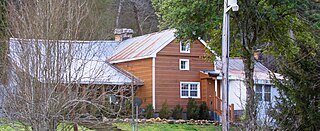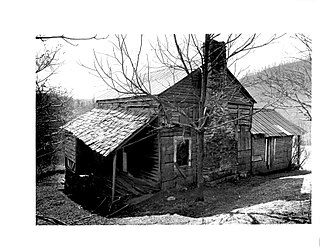
Macon County is a county located in the U.S. state of North Carolina. As of the 2020 census, the population was 37,014. Its county seat is Franklin.

Macon County is a county located in the west central portion of the U.S. state of Georgia. As of the 2020 census, the population was 12,082. The county seat is Oglethorpe.

Dunn is the most populous city of Harnett County, North Carolina, United States. The population was 9,263 at the 2010 census. It is, along with Harnett County, part of the Anderson Creek, NC Micropolitan Statistical Area, which is also included in the Raleigh-Durham-Cary, NC Combined Statistical Area.

Wilson is a city in and the county seat of Wilson County, North Carolina, United States. It is the 23rd most populous city in North Carolina. Located approximately 40 mi (64 km) east of the capital city of Raleigh, it is served by the interchange of Interstate 95 and U.S. Route 264. Wilson had an estimated population of 49,459 in 2019, according to the U.S. Census Bureau, and is also an anchor city of the Rocky Mount-Wilson-Roanoke Rapids CSA, with a total population of 297,726 as of 2018.

Mebane is a city located mostly in Alamance County, North Carolina, United States, and partly in Orange County. The town was named for Alexander Mebane, an American Revolutionary War general and member of the U.S. Congress. It was incorporated as "Mebanesville" in 1881, and in 1883 the name was changed to "Mebane". It was incorporated as a city in 1987. The population as of the 2020 census was 17,768. Mebane is one of the fastest-growing municipalities in North Carolina. Mebane straddles the Research Triangle and Piedmont Triad Regions of North Carolina. The bulk of the city is in Alamance County, which comprises the Burlington Metropolitan Statistical Area, itself a component of the Greensboro-Winston-Salem-High Point Combined Statistical Area. Two slivers in the eastern portion of the city are in Orange County, which is part of the Durham-Chapel Hill Metropolitan Statistical Area, itself a component of the Raleigh-Durham-Chapel Hill Combined Statistical Area.

Nikwasi comes from the Cherokee word for "star", Ꮓꮘꮟ Noquisi (No-kwee-shee), and is the site of the Cherokee town which is first found in colonial records in the early 18th century, but is much older. The town covered about 100 acres (40 ha) on the floodplain of the Little Tennessee River. Franklin, North Carolina, was later developed by European Americans around this site.

The Church of the Incarnation built in 1896 is a historic Carpenter Gothic Episcopal church building located at 111 North 5th Street in Highlands, Macon County, North Carolina.

Coolmore Plantation, also known as Coolmore and the Powell House, is a historic plantation house located near Tarboro, Edgecombe County, North Carolina. Built in 1858–61, the main house is one of the finest Italianate style plantation houses in the state. The house and its similarly styled outbuildings were designed by Baltimore architect E. G. Lind for Dr. Joseph J.W. and Martha Powell. Coolmore was designated a National Historic Landmark for its architecture in 1978, and is a Save America's Treasures projects.

The Hinton Rowan Helper House is a historic house on United States Route 64 outside Mocksville, Davie County, North Carolina. Built on land that once belonged to Daniel Boone, it was the childhood and early adult home of Hinton Rowan Helper (1829-1909) whose The Impending Crisis of the South was an influential antislavery work that inflamed tensions in 1860. The house was added to the National Register of Historic Places and declared a National Historic Landmark in 1973.

U.S. Highway 23 (US 23) in the U.S. state of Georgia is a north–south United States Numbered Highway that travels from the St. Marys River south-southeast of Folkston to the North Carolina state line, in the northern part of Dillard. At nearly 392 miles (631 km) in length, it is the longest U.S. Highway in Georgia.

The Col. James Graham House is a historic log cabin located on West Virginia Route 3 in Lowell, West Virginia. It was built in 1770 as a home for Col. James Graham, the first settler of Lowell, and his family. It was later the site of an Indian attack on the Graham family in 1777. The house was added to the National Register of Historic Places on March 16, 1976. The Graham House is the oldest multi-story log cabin in West Virginia. It is currently operating as a museum.

The John Franklin Cobb House, also known as the Cobb Plantation, is a historic house in rural Cherokee County, North Carolina. The oldest portion of the house is a log structure built in 1863, making it one of the few surviving pre-Civil War structures in the county. It is also notable as a place frequented by baseball legend Ty Cobb in his childhood; he was a grandson of the original builder, John Franklin Cobb. The house is, outside of the log cabin at its core, a rambling structure consisting of a variety of additions to the original log cabin. The house has been enclosed in weatherboarding since the 1880s. It was for many years the center of a farm of some 150-200 acres, and was in the Cobb family until 1977.

The Baldwin-Coker Cottage is a historic house at 266 Lower Lake Road in Highlands, North Carolina. The Rustic-style 1+1⁄2-story log house was designed and built in 1925 by James John Baldwin, an architect from Anderson, South Carolina. The cottage is important as a prototype for a number of later houses that were built by members of the construction crew. The walls are constructed of notched logs, whose ends project at random-length intervals, both at the corners of the house, and from the interior, where logs are also used to partition the inside space. The house is topped by a side-gable wood shingle roof. The main gable ends, and the gables of the dormers, are clad in board-and-batten siding. A porch with naturalistic limb-and-twig railings spans the width of the main facade.
The Dr. Alexander C. Brabson House is a historic house in rural Macon County, North Carolina. It is located off Academy Road near the community of Otto.

The Cowee–West's Mill Historic District encompasses an area of Macon County, North Carolina, which has historic significance predating the arrival of European settlers, and extending into the 20th century. It is located about 6 miles (9.7 km) north of Franklin, the county seat, along either side of Cowee Creek as it flows toward the Little Tennessee River. The district includes the archaeological site and platform mound of the Cherokee town of Cowee, a major settlement until the time of the American Revolutionary War. In the first half of the 19th century the area was developed as a mining community centered on a mill operated by the West family, and after the American Civil War it became one of a small number of rural African-American communities in western North Carolina. The core of the West's Mill area is centered on the junctions of SR 1350, SR 1341, SR 1340, and West's Mill Road, and North Carolina Route 28 is the major road passing through the district. Its northern and southern bounds are roughly where the valley floor gives way to hills on either side of Cowee Creek, ending in the west at Hall Mountain and in the east at the mouth of Caler Creek.

The Charles Noden George House is a historic house in rural Graham County, North Carolina. It is located on the south side of a private road, 0.4 miles (0.64 km) west of SR 1200 and 1 mile (1.6 km) north of United States Route 129, near Tulula Creek. It is a single-pen log structure built c. 1853, which faces east at the top of a 20-acre (8.1 ha) pasture and overgrown orchard. The logs are poplar, and are joined by half-dovetail notches. A fieldstone chimney rises from the uphill side of the structure, and there is a kitchen ell and a wraparound porch on the south and west sides, added c. 1900. It was built by a veteran of the War of 1812 during the second major wave of development in western North Carolina.
The Glen Choga Lodge is a historic lodge in rural Macon County, North Carolina. It is located in a clearing on the south side of Little Choga Road, in Nantahala National Forest. The lodge is a large U-shaped two-story log structure with a metal roof. The Glen Choga Lodge is the only saddle notched Adirondack-style lodge made of Wormy Chesnut Logs known to still exist. It was built in 1934–35, at a time when Little Choga Road was a major route between Franklin and Murphy, North Carolina. The builders were Alexander Breheurs Steuart and his wife Margaret Willis Hays; they operated the lodge as a summer vacation destination until 1941 and the United States entry into World War II. It did not reopen for commercial use after the war, and has been converted into a private summer residence.
The Satulah Mountain Historic District is a residential historic district in Highlands, North Carolina. It is located in the southwestern part of the city, bounded on the north and west by Walhalla Road, on the east by properties on Satulah Road. The area is located on the slopes of Satulah Mountain, and was most significantly developed in the early decades of the 20th century, although the earliest development took place not long after Highlands was founded in 1875. There are a number of log houses, and rustic styling using log and fieldstone elements is common in the area. Many houses have Craftsman features.

The Jesse R. Siler House is a historic house at 115 West Main Street in Franklin, North Carolina. It is prominently sited at the base of the hill on which most of the city is located. A two-story log structure was built on this site c. 1819, and expanded between 1820 and 1830 by Jesse Siler, a prominent early settler of the area. It was modified significantly over the 19th century, most notably receiving a prominent Greek Revival tetrastyle portico. It retains many interior features from Siler's period of modification, exhibiting transitional Georgian-Federal styling in its mantels.
Buck Spring Plantation, also known as the Nathaniel Macon House, is a historic plantation house site located near Vaughan, Warren County, North Carolina. The property includes the graves of politician Nathaniel Macon (1757–1837) and his wife Hannah Plummer Mason, log corn crib, smokehouse, caretaker's house, and reconstructed dwelling house dated to the 1930s.




















